Asia & Africa Food Cans Market Size
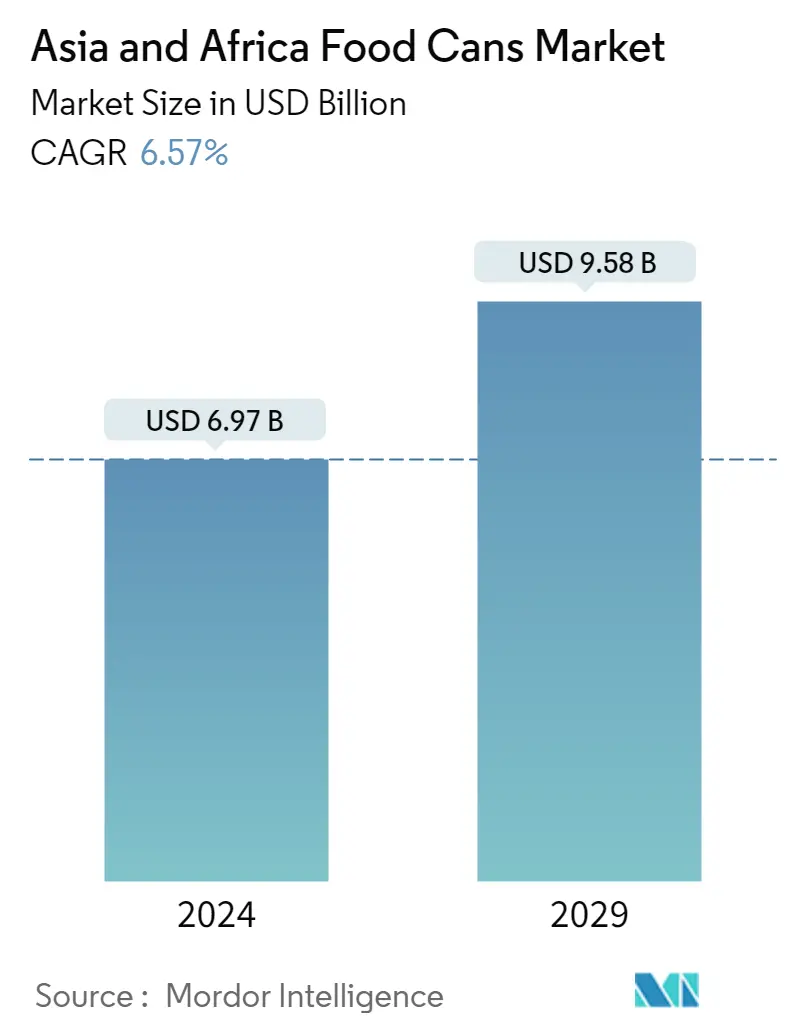
| Study Period | 2019 - 2029 |
| Base Year For Estimation | 2023 |
| Market Size (2024) | USD 6.97 Billion |
| Market Size (2029) | USD 9.58 Billion |
| CAGR (2024 - 2029) | 6.57 % |
| Market Concentration | Medium |
Major Players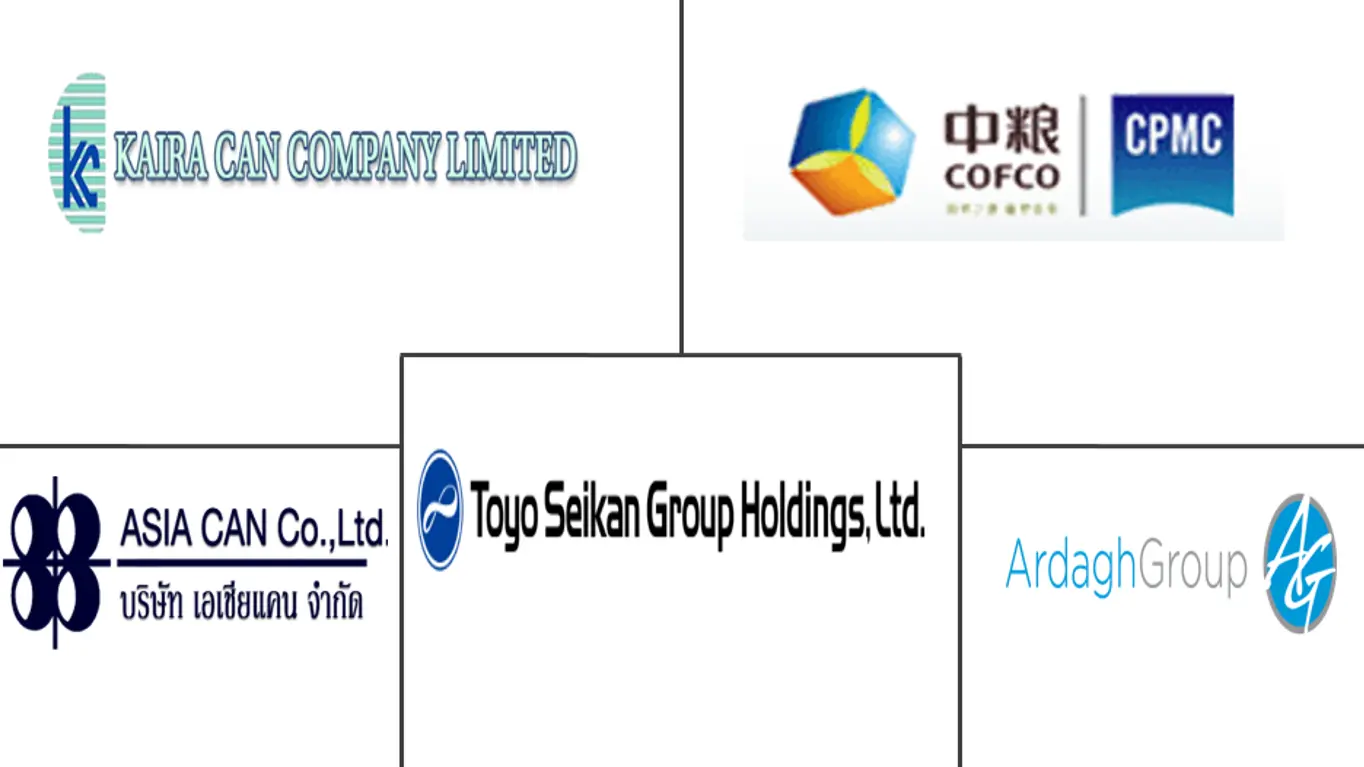
*Disclaimer: Major Players sorted in no particular order |
Asia & Africa Food Cans Market Analysis
The Asia and Africa Food Cans Market size is estimated at USD 6.97 billion in 2024, and is expected to reach USD 9.58 billion by 2029, growing at a CAGR of 6.57% during the forecast period (2024-2029).
COVID-19 has brought a slew of changes to food consumption. Food and grocery purchase patterns highlighted the changing consumer preferences; shelf-stable foods and canned goods were positioned on top of the grocery shopping list. Moreover, newer products were aligned to have immune system boosting ingredients and nutritional aspects. Frozen foods, among Asian consumers amid the COVID-19 pandemic, garnered growth during lockdowns and tightening economics.
- The excellent preservative properties and structural integrity of the metal cans, offering higher shelf life, have resulted in the high usage of metal cans in the food packaging industry across Asia and Africa. Packaged and convenience foods have become a staple diet for many consumers, owing to their hectic lifestyles and work schedules. For instance, according to the Population Reference Bureau, in 2019, the degree of urbanization (percentage of the urban population in total population) across the world was around 54%.
- According to IIED, across the Asian counterparts, the percentage of the world's urban population living in the region was estimated at 53.9% in 2020. Also, Africa is projected to have the fastest urban growth rate in the world, i.e., by 2050, African cities may be home to an additional 950 million people.
- Metal industries in the respective regions demonstrate a net flourishing trend. In Africa, between ZAR 100 million and ZAR 200 million per year is expected to flow into the scrap metals and recycling industry due to the conversion from tin-plated steel cans to aluminum cans. Also, the industry may provide an additional 2,000-3,000 people a source of income from collecting and selling used cans, as per a reputed beverage can manufacturer, Nampak Bevcan.
- Asian trends are mixed with Southeast Asia's growth. Multiple manufacturers from China and Japan have expanded their footprint in the region. For instance, via its Project 2020+, Showa Aluminum Can Corporation has focused on the growth acceleration of its business in the medium-term by targeting Southeast Asia.
- Then, as of October 2020, multiple large steel projects located in Southeast Asia were underpinned by Chinese investment. At the same time, Southeast Asia reportedly gained attention as more food companies shifted away from plastic containers for more recyclable cans. UACJ Corporation, a Tokyo-based company, is expected to boost the output capacity of aluminum sheets at its Southeast Asian plants by 2021.
Asia & Africa Food Cans Market Trends
This section covers the major market trends shaping the Asia & Africa Food Cans Market according to our research experts:
Fruits and Vegetables to Drive the Market Growth
- Canned fruits and vegetables cost less when compared to frozen alternatives or fresh alternatives without compromising nutrition. The only drawback for canned vegetables is the sodium content, but consumers can choose lower sodium versions or rinse the vegetables.
- According to the United Nations agency report published in January 2021, 1.3 billion South Asians could not afford a healthy diet. Further, the pandemic has increased the prices of fruits, vegetables, and dairy products, making canned fruits and vegetables a better option.
- From the production point of view, India and China are the primary producers of vegetables and fruits. According to the Food and Agriculture Organization, in 2019, China produced 588.26 million metric ton of fresh vegetables, followed by India at 132.03 million metric ton. The massive production of vegetables creates opportunities for canning to increase the shelf life.
- The exports are also triggering the quality improvement of the canned vegetable and fruit exports. For instance, according to a memorandum signed by China and Canada, the Chinese canned vegetables have specific export requirements.
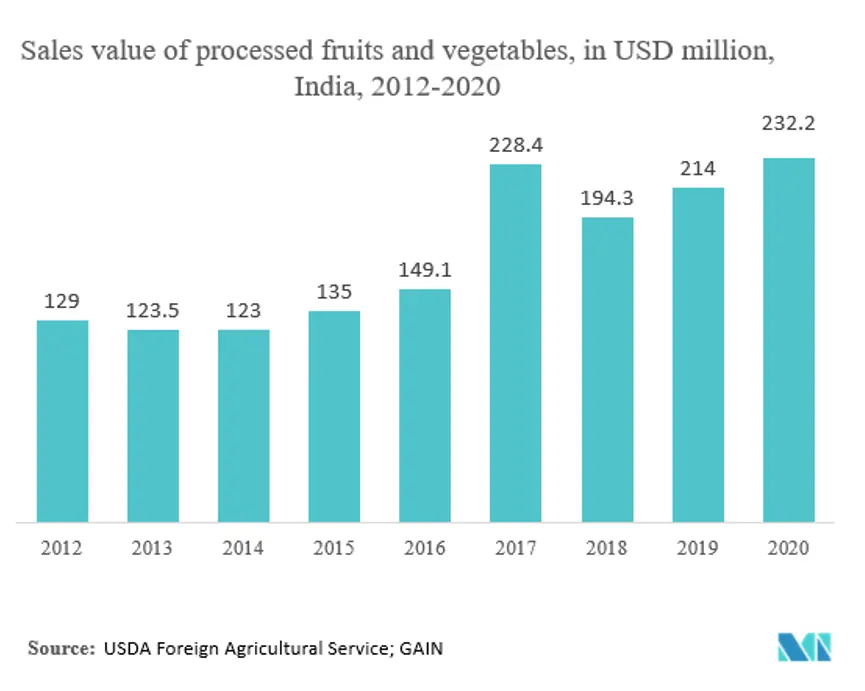
South Korea to Witness Significant Growth Rate
- South Korea has seen growth in items such as processed meat, vegetables, and processed vegetables. According to the National Statistics database of Korea (KOSIS), the average monthly expenditure on processed meat per household increased from KRW 12,190 to KRW 14,470 in 2020.
- Similarly, the expenditure on vegetables and processed vegetables increased from KRW 33,580 in 2019 to KRW 41,370 in 2020. Thus, the growth in the processed meat and vegetables in the country creates the need for appropriate packaging, such as cans.
- The government is making efforts to reduce its plastic waste production by half and more than double recycling rates from 34% to 70% by 2030.
- Also, in May 2020, the government revised the standards and specifications for food contact materials. The revision is for common manufacturing standards and specifications, including improved methods and layouts for food utensils, containers, and packaging.
- The standards also include clarification on the use of recycled plastic resins. Hence, government initiatives encourage the push away from plastics and other materials such as steel and aluminum, thus driving the country's food cans.
- The COVID-19 pandemic has played a significant role in the shift toward canned food, thus driving the market for food cans. For instance, according to a survey by Shinsegae, as of February 2020, the online sales of canned food increased by a significant 268%, followed by rice (187%), instant noodles (175%), and prepared meals (168%).
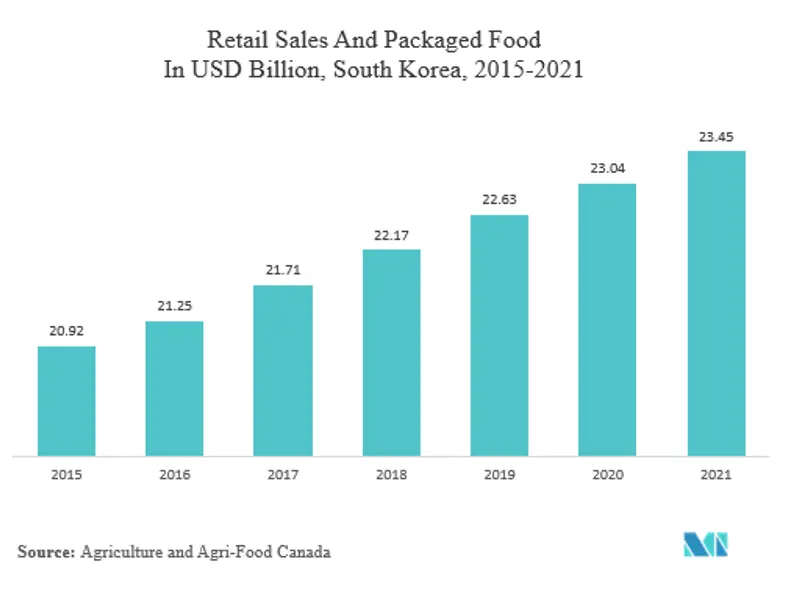
Asia & Africa Food Cans Industry Overview
The Asian and African food cans market is characterized by moderate competitiveness among key market players and an increase in the number of new entrants. Market players are further focusing on research and development to integrate advanced functions and capabilities into media players. The companies keep on innovating and entering strategic partnerships to retain their market share.
- February 2021 - Ardagh Group entered an agreement to merge its Metal Packaging business segment with Gores Holdings V, thereby creating a public listed company. The agreement would see Gores Holdings V, a special purpose acquisition company, merge with Ardagh's Metal Packaging (AMP) division to form the newly created Ardagh Metal.
Asia & Africa Food Cans Market Leaders
-
Asia Can Co. Ltd
-
kaira Can LTD
-
Toyo Seikan Group Holdings Ltd
-
ARDAGH GROUP SA
-
CPMC Holdings Limited
*Disclaimer: Major Players sorted in no particular order
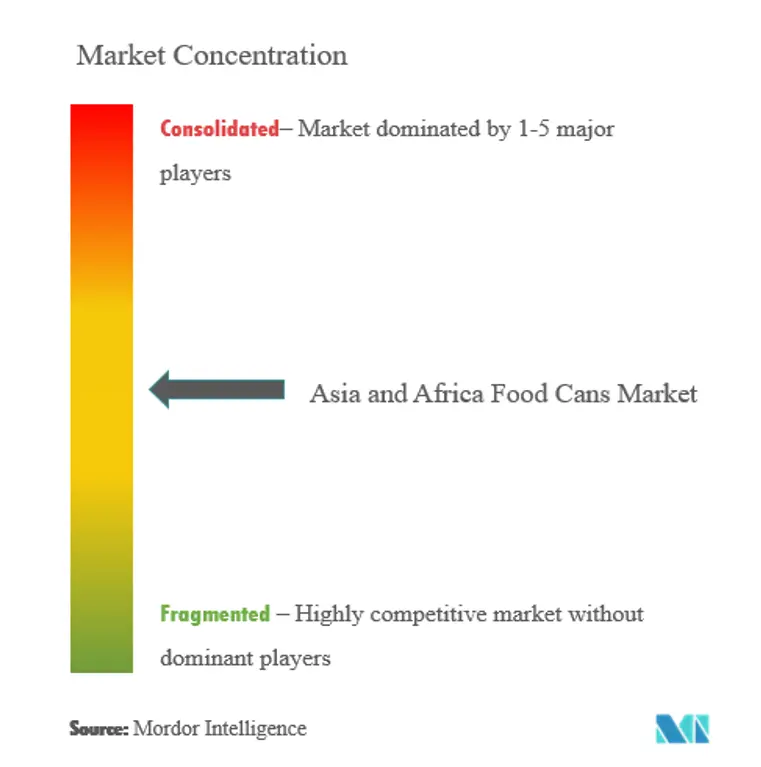
Asia & Africa Food Cans Market News
- February 2021 - Tyson Foods and Malayan Flour Mills Berhad (MFM) announced a partnership in which Tyson Foods is expected to invest in MFM's vertically integrated poultry business, thus adding more supply flexibility for both companies.
- November 2020 - Nestle announced the expansion of its cereal business production in Zimbabwe. It aims to increase its production by more than 30%.
Asia & Africa Food Cans Market Report - Table of Contents
1. INTRODUCTION
- 1.1 Study Assumptions and Market Definition
- 1.2 Scope of the Study
2. RESEARCH METHODOLOGY
3. EXECUTIVE SUMMARY
4. MARKET DYNAMICS
- 4.1 Market Overview
-
4.2 Market Drivers
- 4.2.1 High Recyclable Score of Metal Cans over Alternatives
- 4.2.2 Demand for Canned Foods Driven by Cost and Convenience-related Advantages
- 4.2.3 Product Innovations Leading to Increased Shelf Life
-
4.3 Market Challenges
- 4.3.1 Plastic Remains a Highly Credible Alternative in the Regions
- 4.4 Market Opportunities
-
4.5 Industry Attractiveness - Porter's Five Forces Analysis
- 4.5.1 Bargaining Power of Suppliers
- 4.5.2 Bargaining Power of Consumers
- 4.5.3 Threat of New Entrants
- 4.5.4 Intensity of Competitive Rivalry
- 4.5.5 Threat of Substitutes
- 4.6 Industry Supply Chain Analysis
- 4.7 Impact of COVID-19 on the Market
5. Market Segmentation
-
5.1 Material
- 5.1.1 Aluminum Cans
- 5.1.2 Steel/Tin Cans
-
5.2 Can Type
- 5.2.1 2-piece
- 5.2.2 3-piece
-
5.3 Application
- 5.3.1 Fish and Seafood
- 5.3.2 Fruits and Vegetables
- 5.3.3 Processed Food
- 5.3.4 Pet Food
- 5.3.5 Other Applications
-
5.4 Geography
- 5.4.1 Asia
- 5.4.1.1 China
- 5.4.1.2 India
- 5.4.1.3 South Korea
- 5.4.1.4 Southeast Asia
- 5.4.2 Africa
- 5.4.2.1 South Africa
6. COMPETITIVE LANDSCAPE
-
6.1 Company Profiles*
- 6.1.1 Crown Holdings Inc.
- 6.1.2 ORG Packaging Co. Limited
- 6.1.3 Kian Joo Can Factory (Can One)
- 6.1.4 Silgan Holdings Inc.
- 6.1.5 CPMC Holdings Limited
- 6.1.6 Kaira Can Private Limited
- 6.1.7 Toyo Seikan Group Holdings Ltd
- 6.1.8 Ardagh Group
- 6.1.9 Asia Can Co. Ltd
- 6.1.10 Royal Cans Industries Company
- 6.1.11 CanSmart Group
- 6.1.12 MC Packaging (Pte) Ltd
- 6.1.13 Dongwon Systems
- 6.1.14 Can It
- 6.1.15 Nampak Ltd
7. INVESTMENT ANALYSIS
8. FUTURE OF THE MARKET
** Subject To AvailablityAsia & Africa Food Cans Industry Segmentation
The food can is a container for distributing or storing processed food, seafood, fish, etc. It is composed of thin metal, which is prominently gaining popularity due to its growing use in food packaging. Changing lifestyles, growing canned food requirements, and the rising need for processed foods are marking the growth of this market. The market is segmented by material, can type, and application.
| Material | Aluminum Cans | |
| Steel/Tin Cans | ||
| Can Type | 2-piece | |
| 3-piece | ||
| Application | Fish and Seafood | |
| Fruits and Vegetables | ||
| Processed Food | ||
| Pet Food | ||
| Other Applications | ||
| Geography | Asia | China |
| India | ||
| South Korea | ||
| Southeast Asia | ||
| Geography | Africa | South Africa |
Asia & Africa Food Cans Market Research FAQs
How big is the Asia and Africa Food Cans Market?
The Asia and Africa Food Cans Market size is expected to reach USD 6.97 billion in 2024 and grow at a CAGR of 6.57% to reach USD 9.58 billion by 2029.
What is the current Asia and Africa Food Cans Market size?
In 2024, the Asia and Africa Food Cans Market size is expected to reach USD 6.97 billion.
Who are the key players in Asia and Africa Food Cans Market?
Asia Can Co. Ltd , kaira Can LTD , Toyo Seikan Group Holdings Ltd , ARDAGH GROUP SA and CPMC Holdings Limited are the major companies operating in the Asia and Africa Food Cans Market.
What years does this Asia and Africa Food Cans Market cover, and what was the market size in 2023?
In 2023, the Asia and Africa Food Cans Market size was estimated at USD 6.54 billion. The report covers the Asia and Africa Food Cans Market historical market size for years: 2019, 2020, 2021, 2022 and 2023. The report also forecasts the Asia and Africa Food Cans Market size for years: 2024, 2025, 2026, 2027, 2028 and 2029.
Asia & Africa Food Cans Industry Report
Statistics for the 2024 Asia & Africa Food Cans market share, size and revenue growth rate, created by Mordor Intelligence™ Industry Reports. Asia & Africa Food Cans analysis includes a market forecast outlook to 2029 and historical overview. Get a sample of this industry analysis as a free report PDF download.



